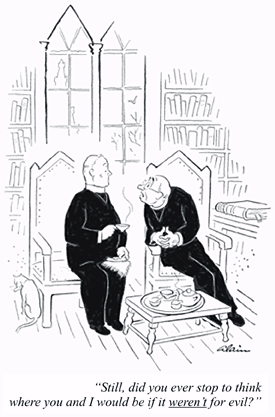Chapter 12
Religious Violence
I was walking across a bridge one day, and I saw a man standing on the edge, about to jump off. So I ran over and said, “Stop! Don’t do it!” “Why shouldn’t I?” he said. I said, “Well, there’s so much to live for! He said, “Like what?” I said, “Well… are you a religious man or an atheist?” He said, “Religious.” I said, “Me too! Are you Christian or Buddhist?” He said, “Christian.” I said, “Me too! Are you Catholic or Protestant?” He said, “Protestant.” I said, “Me too! Are you Episcopalian or Baptist?” He said, “Baptist.” I said, “Wow! Me too! Are you Baptist Church of God or Baptist Church of the Lord?” He said, Baptist Church of God.” I said, “Me too! Are you Original Baptist Church of God, or are you Reformed Baptist Church of God?” He said, “Reformed Baptist Church of God.” I said, “Me too! Are you Reformed Baptist Church of God, reformation of 1879 or Reformed Baptist Church of God, reformation of 1915?” He said, “Reformed Baptist Church of God, reformation of 1915.” I said, “Die, heretic scum.”
and pushed him off.
—Emo Phillips, comedian

© The New Yorker Collection 1943
Alain from cartoonbank. com
All Rights Reserved
Religion has been linked to the best and worst in human behavior. It provides a beacon for moral order. Faith inspires people to transcend self-interest, to love and serve others, and aspire to higher truths. Yet religion is also linked to evil behavior, murder and war. According to Charles Kimball, author of When Religions Become Evil, more wars have been waged, and more killing has been perpetrated under the banner of religion than by any other institution throughout history. Paradoxically, the goal of all this violence is peace. Almost every religion has blood on its hands—Hinduism, Buddhism, Christianity, Islam, Judaism, Confucianism, Shintoism, and the rest. Since religious traditions are human institutions, and humans are fallible, all religions are susceptible to corruption, becoming vehicles for violent, destructive, and malevolent behavior.
Does God condone killing, or does man ascribe it to God’s will? Do Holy Scriptures endorse murder, or have they been misinterpreted and taken out of context? Can seemingly contradictory passages, one endorsing peace, another justifying violence, be reconciled? Can God be on my side, but not on my enemy’s? Does religion sanction violence, or has it been hijacked by fanatics or lunatics to justify criminal behavior? If God and Holy Scriptures do support killing, under what circumstances is it justified? Does religion become evil, or does evil appropriate religion. What distinguishes authentic, life affirming forms of religious expression from corrupt forms? These are very difficult questions. They have troubled the mind, and tested the soul of man for centuries. Understanding violence is especially important today, given irrational state leaders in Iran and North Korea, terrorists’ suicide bombings, and alleged efforts by terrorist organizations to obtain WMDs with the intent to destroy people of other faiths and secular nations.
“It is all too human to compare the ideal version of one’s own religion with the visibly flawed lived reality of other religions—a tendency found in all religions.”[1]
Kimball describes five warning signs that expose a common pattern in religious corruption:
- Absolute truth claims
Claims of truth are the essential ingredients of religion, and they permeate religious traditions. In order to be a believer in any religion, one must accept them. However, with the multitude of religions and religious denominations, divergent interpretations inevitably arise. The absolute truth claims that are dangerous are the ones that claim that non-believers should be slain, enslaved, subjugated, or marginalized in any way.
- Blind obedience
Any leader (e.g., Hitler) or religious or political institution that disengages the mind of people, limits intellectual freedom, instructs its adherents to withdraw from society and abdicate personal responsibility, or yield to a particular authority becomes the framework through which such leaders and movements become evil, violent, and destructive.
- Establishing the “ideal” time
Jewish and Christian fundamentalist groups share a vision that a third Jewish Temple will be rebuilt in the area of the Temple Mount. Their vision is predicated on particular interpretations of certain selected scriptural passages. A blueprint to establish an “ideal” time, place, or even a nation-state, whether a Christian America, a Jewish Israel, or an Islamic Iran, which seeks to impose the rule of God’s law by removing political institutional structures, and depends on human beings to implement, is a sign of corrupted religion.
- The end justifies any means
Concern for one’s community is good. But when reinforcing a group’s identity against outsiders, as well as from within its ranks, becomes an essential or paramount end, justified by any means, it usually results in unthinkable behavior and dehumanizing violence. Discrimination that results from these phenomena ranges from officially sanctioned racism, class distinction, and sexism at the relatively benign end of the spectrum, to mass rape and murder, ethnic cleansing and genocide at the malignant end of the spectrum.
- Declaring “holy war”
At the heart of every authentic religion is the promise of inner peace for the adherent and a requirement to seek outer peace in the form of compassionate, constructive relationships with one’s neighbors. The decisive use of force and military intervention may be necessary based on political motives, but a “holy war” is an oxymoron, a corruption of authentic faith. Religion is more powerful than ideology because it moralizes political self-interest. It is a convenient cover for human acts of greed and power. Under the just war doctrine, war must be waged only under the lawful authority of a ruler.
[1]Charles Kimball, When Religion Becomes Evil, (New York: HarperCollins, 2003).
|
|